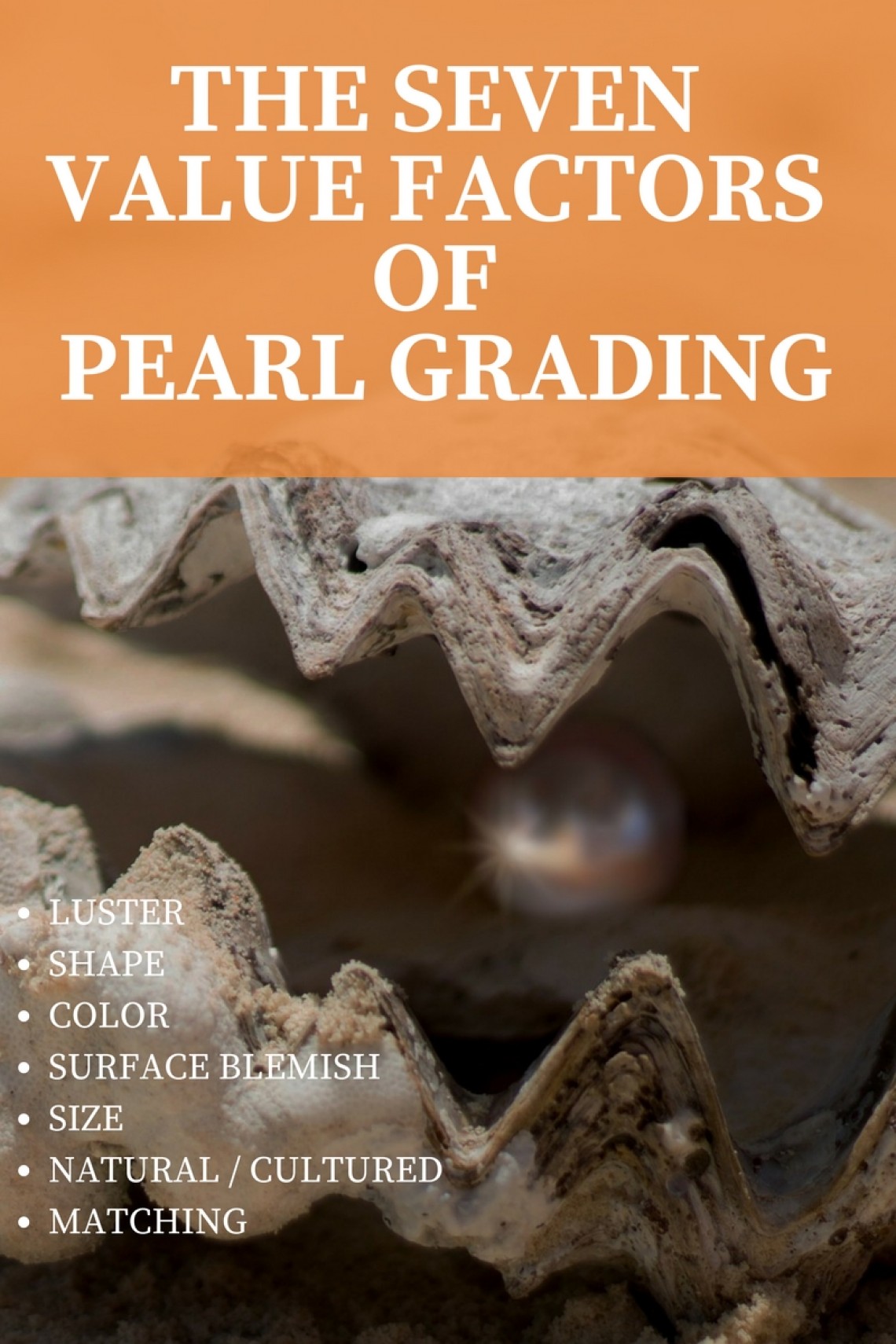
公開日9th May 2018
変更日時4th Jun 2025
真珠のグレード - 7つの価値要因
 真珠の等級に影響を与える7つの価値要因は複雑で、習得には何年もかかります。多くの人は、真珠には様々な種類があることを知りません。ましてや、ダイヤモンドのように真珠を等級分けする方法など、知る由もありません。真珠の等級分けは様々な要因に基づいており、真珠の種類ごとに異なる等級分けシステムがあります。例えば、アコヤ真珠等級分け、タヒチ真珠等級分け、淡水真珠等級分け、南洋真珠等級分けなどがあります。そこで、ここでは様々な真珠の価値要因と、それらが真珠の色の等級分けにどのような影響を与えるのかを見ていきましょう。
真珠の等級に影響を与える7つの価値要因は複雑で、習得には何年もかかります。多くの人は、真珠には様々な種類があることを知りません。ましてや、ダイヤモンドのように真珠を等級分けする方法など、知る由もありません。真珠の等級分けは様々な要因に基づいており、真珠の種類ごとに異なる等級分けシステムがあります。例えば、アコヤ真珠等級分け、タヒチ真珠等級分け、淡水真珠等級分け、南洋真珠等級分けなどがあります。そこで、ここでは様々な真珠の価値要因と、それらが真珠の色の等級分けにどのような影響を与えるのかを見ていきましょう。
7つの価値要因
1. 光沢
光沢は真珠の輝きの明るさを測るものであり、真珠が光をどれだけよく反射するかをテストするものです。
2. 形状
真珠の形は重要です。丸いほど価値が高まります。バロック真珠は形が不規則で珍しいため、真珠養殖業者は一生かけて完璧な丸い真珠を一連集めることもあります。

3. 色
真珠の色は、それが生成された水の種類、それを生成した貝、そしていくつかの環境要因によって決まります。色が濃いほど、真珠は希少で高価になります。真珠は通常、白、クリーム、黒、灰色、銀といったメインカラー(地色)を持つと言われています。真珠を詳しく観察すると、倍音と呼ばれる二次的な色の存在が分かります。これらは緑、青、紫、ピンクなどです。真珠によっては虹色の倍音を呈するものがあり、この効果はオリエント効果と呼ばれます。 
4. 表面の傷
真珠の外側が完璧であればあるほど、つまり傷やへこみがなく、より高価になります。とはいえ、自然界に完璧なものなど存在しないため、必ず何らかの傷は存在します。たとえそれが人間の目には見えなくても。 
5. サイズ
この場合、真珠は大きいほど良いです(高価なものを探している場合)。
6. 天然か養殖か
残念ながら、市販されている真珠のほとんどは、何らかの方法で人間によって養殖・製造されたものです。これらの真珠は、天然真珠に比べて価値が低いです。養殖真珠は通常、中国で採取される淡水真珠です。これらの真珠の養殖場は巨大です。 
7. マッチング
名前の通り、マッチングとは、セット内の他の真珠とどれだけよくマッチしているかのことです。マッチングパールを見つけるのは難しいですが、マッチングセットを見つけるのはさらに困難です。セレブリティがグレードマッチパールを身に着けているのをよく見かけます。グレードマッチパールとは、色と形がすべて揃っているという意味で、前面の真珠が大きく、後ろに向かって徐々に小さくなるパールのことです。それを見つけるのにどれだけ時間がかかるか想像してみてください。

真珠の色について
真珠の色は、虹のスペクトル全体をほぼ網羅しています。白、ピンク、クリーム、シルバー、ゴールド、ライトブルーといった明るい色の真珠があります。それとは対照的に、緑、紫、チョコレート、グレー、ダークブルーといった濃い色の真珠もあります。前述のように、真珠の色は様々な要因によって決まりますが、主な要因の一つは、その真珠を生み出した貝の「遺伝」です。また、その貝が生息する水の状態も大きな要因となります。例えば、以下のようなことが挙げられます。
- 淡水
- 海水
- 水が汚染されている場合
- 何らかの理由で水に栄養分が不足している場合
真珠の色は通常、一種のツートンカラーで、メインの色とその上に異なる色の基調があります。
真珠の等級付けには様々な方法がありますが、完璧な真珠とは何かについては専門家の間でも依然として多くの議論があります。その多くは人間の好みによるものです。
真珠を買う
Gemstone Encyclopedia検索
関連オークション
関連記事
誰もが自分の星座に対応した宝石を持っています。これらはスターストーンとも呼ばれています。これらの石についてもっと詳しく知り、あなたのスターストーンを見つけましょう。
10th May 2018
タヒチ真珠は、さまざまな形、サイズ、色がある、美しい濃い色の真珠です。この宝石について詳しく知り、当社が販売している美しい真珠をご覧ください。
9th May 2018
金塊はどのように形成されるのでしょうか?多くの金塊は、多くの宝石が形成されるのと同様に、溶融した金が流動性を持ち、母岩の亀裂や割れ目に浸透することで形成されます。
15th Oct 2020
最新記事
鮮やかな赤い模様と文化的意義で珍重される希少な宝石、チキンブラッドストーンの歴史、特性、価値、お手入れのヒントをご紹介します。
8th Dec 2025
ゲイラス石は、乾燥しやすいため白濁しやすい希少鉱物で、主に工業用途で使用されています。この完全ガイドで、ゲイラス石の歴史、特性、用途、そして特徴をご覧ください。
7th Dec 2025
チオライトは、氷晶石に似た、無色から白色の希少鉱物です。宝石としては非常に希少で、限られた産地からしか産出されません。チオライトの用途、歴史、価格、特徴についてはこちらをご覧ください。
5th Dec 2025
記事のカテゴリ
How To's is where you will find helpful articles from gem Rock Auctions on how to cut gemstones, select gemstones and buy gemstones.
9記事数





